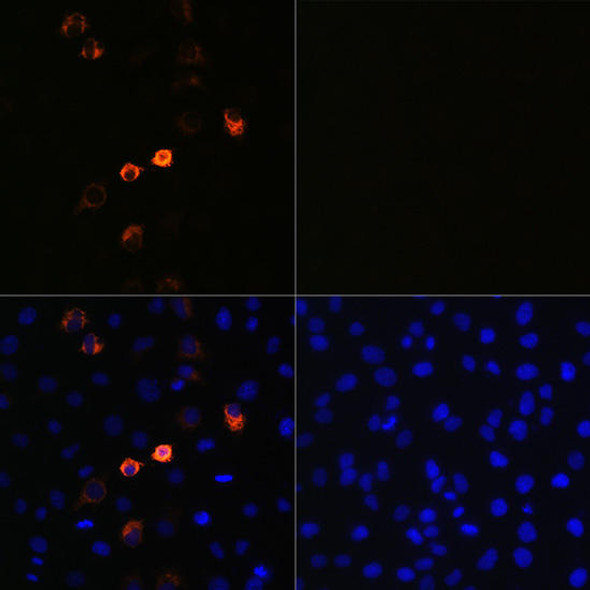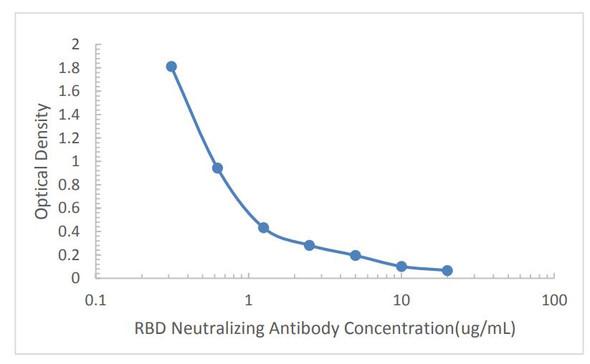COVID-19 (SARS-CoV-2) Triplex RT-qPCR Detection Kit
- SKU:
- VA0001
- Product Type:
- Biosimilar Antibody
- Antibody Type:
- Monoclonal Antibody
- Protein:
- BAFFR
- Isotype:
- IgG1
- Reactivity:
- Human
- Host Species:
- Human
- Synonyms:
- BAFFR, TNFRSF13C, BAFF-R, BROMIX, CD268, CVID4, prolixin
Description
COVID-19 (SARS-CoV-2) Triplex RT-qPCR Detection Kit
This product is a multiplex fluorescent probe-based RT-qPCR assay system for the detection of COVID-19, the disease caused by the novel coronavirus SARS-CoV-2. The Taqman fluorescent probe is a specific oligonucleotide based on a reporter-quencher mechanism. For each probe, the 5’-end is labeled with a fluorophore, while the 3’-end is labeled with a quencher. When the probe is intact, the fluorescence emitted by the fluorophore is absorbed by the quencher, and no fluorescent signal is detected. However, if during amplification of the template the probe is degraded due to the 5'-3’ exonuclease activity of Taq DNA polymerase—and the fluorescent reporter and the quencher are cleaved and separated— then a fluorescent signal can be detected. The generation of each molecular amplicon is accompanied by the generation of a fluorescent signal. Realtime monitoring of the entire PCR process can be assessed by monitoring the accumulation of fluorescent signals.
This product provides triplex-detection in a single tube, including two independent genes of SARS-CoV-2 and an internal control which targets the human RNAse P (RNP) gene to assess specimen quality. Specific primers and probes were designed for the detection of conserved region of SARS-CoV-2’s ORF1ab gene and N gene, respectively, avoiding nonspecific interference of SARS2003 and BatSARS-like virus strains. Internal control (RNAse P gene) provides a nucleic acid extraction procedural control and a secondary negative control. Positive control (SARS-CoV-2-pseudoviruse) provides a nucleic acid extraction and a reverse transcription control to validate the entire procedure and reagent integrity.
COVID-19 (SARS-CoV-2) Triplex RT-qPCR Detection Kit Contents
| Components | Amount | Ingredients |
|
Detection buffer |
900μL × 2 tubes |
Buffer, dNTPs, Primers, Probes. |
|
Enzyme mix |
400μL × 1 tube |
RNase Inhibitor, UDG, Reverse Transcriptase, Taq DNA polymerase. |
|
Positive Control |
250μL × 1 tube |
RNA pseudovirus containing target gene. |
|
Negative Control |
250μL × 1 tube |
DEPC-Treated Water. |
Storage & shelf life
- All reagents should be stored at -30°C to -15°C with protection from light. The reagents are stable for 6 months when stored at the recommended condition.
- The expiration date will not change if the kit is opened and stored at the recommended condition.
- The expiration date will not change if the kit is transported with ice-packs for 4 days and/or treated with 10 freeze-thaw cycles.
Instruments
- Real-time PCR instrument with FAM, TEXAS RED/ROX and HEX/VIC channels, such as ABI7500, ABI Q3, ABI Q6,
- Roche LightCycler480
- Bio-Rad CFX96
Sample handling
- Suitable specimen type: upper respiratory specimen (including nasal swabs, nasopharyngeal swabs / aspirates / washes, and sputum) and lower respiratory specimen (including respiratory aspirates, bronchial washes, bronchoalveolar lavage fluids, and lung biopsy specimens).
- For detailed methods of specimen collection, please refer to the protocol in the "Microbiology Specimen Collection Manual".
- The collected specimen should be used for detection within the same day. Otherwise, please store the specimen as follows:
- Store at 2°C - 8°C for no more than 24 hours;
- Store at < -20°C for no more than 10 days;
- Store at < -70°C for long-term, avoiding repeated freeze-thaw cycles.
- The specimen should be transported using sealed foam box with dry ice.
Protocol
1. Specimen Preparation (Specimen Preparation Area)
The samples should be extracted according to the corresponding requirements and procedures of viral RNA extraction kits. Each nucleic acid extraction procedure must be performed simultaneously with one positive control (add 5μL, dilute with sterile saline solutions to desired volume) and one negative Control (add 5μL, dilute with sterile saline solutions to desired volume).The extracted RNA can be directly used for detection. If the extracted RNA is not used for detection immediately, please store the RNA below -70°C, avoiding repeated freeze-thaw.
2. Reagent Preparation (PCR Reagent Preparation Area)
Thaw the required reagents, mix by shaking, and centrifuge briefly before use. Prepare the mixture in a RNase-free centrifuge tube as follows[1]:
| Components | Volume Per Reaction (uL) |
|
Detection Buffer |
26 |
|
Enzyme Mix |
4 |
|
Total Volume |
30 |
[1] Calculate the number of reaction tubes (sample number + positive control + negative control). It is recommended to set both negative and positive controls for each test.
Mix the above mixture thoroughly, and make aliquots of 30 μL into different PCR reaction tubes. Then, move to the Specimen Preparation Area.
3. Template Addition (Specimen Preparation Area)
Add 20 μL of extracted Negative Control products, 20 μL of extracted Positive Control products, and 20 μL of extracted RNA from specimen to different PCR reaction tubes which contained 30 μL of PCR mix. The total volume is 50 μL. Cap the reaction tubes tightly, centrifuge them at low speed. Then, move to the Detection Area.
4. RT-PCR Amplification (Detection Area)
Put the reaction tubes on a PCR instrument, setup and run the following cycling protocol:
| Step | Name | Cycles | Temp | Time |
|
Step 1 |
Reverse Transcription |
1 |
50 C° |
15 min |
|
Step 2 |
Pre-denaturation |
1 |
95 C° |
30 sec |
|
Step 3 |
PCR Cycles |
45 |
95 C° 58 C° (read) |
10 sec 30 sec |
Settings of detection fluorescence: ORF1ab gene (FAM), N gene (TEXAS RED / ROX), Internal Control (HEX/VIC). Please set the internal reference parameter of fluorescence of the instrument to “None”. For example: for ABI series instruments, please set “Passive Reference” to “None”.
5. Data Analysis (refer to Instrument User Manual)
Take ABI7500 as an example: after the qPCR reaction, the results were saved automatically. According to the analyzed image, adjust the Start value, End value, and Threshold value of the Baseline (Start value: 3 ~ 15; End value: 5 ~ 20; Threshold value could be set in the Log window, and the threshold line should be in the exponential phase of the amplification curve; the amplification curve of the negative control should be straight or below the threshold line).
Click ”Analysis” to obtain the analysis result automatically, and read the detection result in the "Report" window.
Quality Control
| Channel | Normal Ct | |
|
Negative Control |
FAM TEXAS RED/ROX HEX/VIC |
No Ct or Ct > 38 No Ct or Ct > 38 No Ct or Ct > 38 |
|
Positive Control |
FAM TEXAS RED/ROX HEX/VIC |
Ct ≤ 33 Ct ≤ 33 Ct ≤ 33 |
The result is valid if ALL the above criteria is met. Otherwise, the result is invalid.
Interpreting Test Results
If the criteria of QUALITY CONTROL is met, analysis the data of sample as follows:
1. If the Ct value of HEX/VIC (Internal Control) channel is >33, it may indicate that the detected specimen contains lower concentration of cells, extracted nucleic acid was degraded or certain inhibitors were present in the reaction.
2. If the Ct value of HEX/VIC channel is ≤ 33, analyzing the results according to the following table:
| Interpreting Test Results | FAM (ORF1ab gene): CT ≤ 38 | FAM (ORF1ab gene): No CT or CT > 38 |
|
TEXAS RED/ROX (N gene) CT ≤ 38 |
2019-nCOV Positive |
Test again, and if repeated: 2019-nCOV Negative; If not: suspicious * |
|
TEXAS RED/ROX (N gene) No CT or CT > 38 |
Test again, and if repeated: 2019-nCOV Positive; If not: suspicious * |
2019-nCOV Negative |
*No requirement for HEX/VIC channel test results, if the sample is extracted from virus culture.
*For suspicious samples, it is recommended to re-collect specimen or change the collection location, then test the specimen again.
Assay Limitations
- The detection result of this product is only for clinical reference, and it should not be used as the only evidence for clinical diagnosis and treatment. The clinical management of patients should be considered in combination with their symptoms/signs, history, other laboratory tests and treatment responses.
- The detection results should not be directly used as the evidence for clinical diagnosis and are only for the reference of clinicians.
- The detection result can be affected by operations, including specimen collection, storage and transportation. False negative results may occur if there are any mistakes in the operation. Cross contamination during specimen treatment may lead to false positive results.
- The detected target sequences of these products are the conservative region of 2019-nCoV’s ORF1ab gene and N gene. However, target sequence variations may lead to false negative results.
- This kit is for Research-Use-Only.
Performance Specifications
- Detection limitation: 200 copies /mL.
- Precision: using precision reference CV1 and CV2 for within-batch and between-batch detection, the coefficient of variation (CV) of their Ct values is ≤5.0%.
- Conformity rate of Negative Control: 100%
- Conformity rate of Positive Control: 100%
- Specificity: This product will not cross react with positive samples of human coronavirus HKU1 OC43, NL63 and 229E, SARS coronavirus, MERS corona-virus, H1N1 (new influenza A (H1N1) virus (2009), the seasonal H1N1) and H3N2, H5N1, H7N9, influenza B Yamagata, Victoria, respiratory syncytial virus type A, B, parainfluenza type 1, 2, 3, rhinovirus species A, B and C, adenovirus, 1, 2, 3, 4, 5, 7 and 55, enterovirus species A, B, C, D, Human pulmonary virus, partial pulmonary virus, EB virus, measles virus, human cytomegalo virus, rotavirus, norovirus, mumps virus, varicella-zoster virus and mycoplasma pneumoniae, chlamydia pneumoniae, legionella, bordetella pertussis, haemophilus influenzae, staphylococcus aureus, streptococcus pneumoniae, pyogenic streptococcus, klebsiella pneumoniae, mycobacterium tuberculosis, pyogenic streptococcus, candida albicans, candida glabrata, newborn Cryptococcus and human genome DNA.
Attention:
- Please read this manual carefully before beginning the experiment, and strictly follow the instructions.
- This product should be only used by trained labour personnel in safety-protected laboratories and wear appropriate protective equipment.
- This product should be protected from light. Please use sterile, DNase-free, and RNase-free tubes and tips during the detection.
- The tested specimen of this product is regarded as infectious material.
- The operation and treatment should meet the requirements of the local regulations and laws.
| Filchakova et al. | Review of COVID-19 testing and diagnostic methods | Talanta 2022 | View Citation |
| Ryan et al. | Use of exhaled breath condensate (EBC) in the diagnosis of SARS-COV-2 (COVID-19) | Thorax (2020) | PubMed: 33097604 |
| Ryan et al. | The use of Exhaled Breath Condensate (EBC) in the Identification of Driver Mutations in Lung Cancer and SARS-CoV-2 viral RNA in Covid-19. | 2022 | PubMed ID: 33097604 |
Citations
| Filchakova et al. | Review of COVID-19 testing and diagnostic methods | Talanta 2022 | View Citation |
| Ryan et al. | Use of exhaled breath condensate (EBC) in the diagnosis of SARS-COV-2 (COVID-19) | Thorax (2020) | PubMed: 33097604 |
| Ryan et al. | The use of Exhaled Breath Condensate (EBC) in the Identification of Driver Mutations in Lung Cancer and SARS-CoV-2 viral RNA in Covid-19. | 2022 | PubMed ID: 33097604 |







